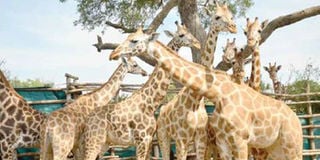There is a sharp increase in giraffe numbers, says report

Giraffes were categorised as vulnerable by the International Union for the Conservation of Nature (IUCN). PHOTO/ FILE
What you need to know:
The international science-based conservation body- giraffe conservation foundation (GCF) that provides innovative approaches to saving giraffes attributes the sharp increase to accurate data.
The latest figures published by the giraffe conservation foundation (GCF) indicate that the giraffe numbers are showing a positive upward trend.
According to the Status of Giraffe 2020 report, latest estimate based on numbers collated across Africa, stands at just over 117,000 giraffes in the wild.
“While this is still a precariously low number – particularly compared to African elephants: there is only one giraffe for every three to four elephants in Africa – we can see encouraging signs,” GCF adds.
According to GCF, the iconic giraffe and their habitat remain under a high level of conservation threat. In 2016, giraffes as a single species were categorised as ‘vulnerable’ by the International
Union for the Conservation of Nature’s (IUCN) red list, following the analysis of the IUCN Species Survival Commission (SSC) Giraffe and Okapi Specialist Group (GOSG) with significant input from GCF.
Dr Julian Fennessy, co-founder and director of GCF says: “In some giraffe populations, we singlehandedly doubled the number of giraffes through improved survey methods – or to put it simply: by counting them better.”
To better understand the current situation and how giraffe numbers have evolved since the IUCN assessment was completed in 2015, GCF led a comprehensive review of giraffe current abundance and evaluated these trends.
With the new classification of four distinct species of giraffe, GCF could better define the conservation status of each species and understand the diverse challenges they face throughout Africa.
Conservation efforts “Our understanding of the conservation status of giraffes is constantly evolving with new incoming data on diversity, distribution and abundance.
This study combines the dedicated efforts of teams throughout Africa to incorporate the most recent numbers into our understanding of giraffe abundance in the continent,” says Dr Michael
Brown, a conservation scientist with GCF and Smithsonian Conservation Biology Institute.
“The good news is that overall giraffe numbers are on the rise Tourism. The sharp increase can be attributed to more accurate survey data rather than a substantial population growth. Additional targeted surveys are required to better assess the status of reticulated giraffe in the wild,’’ says Dr Michael Brown.
There is a sharp increase in giraffe numbers, says report and that the conservation efforts
GCF and many of our partners are undertaking appear to be showing success.” Estimated at a total of 97,562 individuals in 2015, our 2020 review shows a 20 percent growth to 117,173 giraffes in the wild today.
Most importantly, these numbers are increasing across all recently defined four species of giraffe. This is the first time that such trends have been reported in recent history,” GCF says. Northern giraffe
Consisting of three subspecies – Kordofan (giraffe camelopardalis antiquorum), Nubian (G. c. camelopardalis) and West African (G. c. peralta) giraffe – northern giraffe remain distributed in small, fragmented populations across east, central and west Africa.
It is important to note that the formerly recognised Rothschild’s giraffe is genetically indistinguishable from the Nubian giraffe, and are, therefore, incorporated into them. While numbers remain precariously low, their increasing numbers show a positive trend, particularly in Chad, the DR Congo and Niger.
The numbers of the northern giraffe stood at 4,776 in 2015 which have grown to 5,919 in 2020 (24 percent increase). The proposed conservation status of the northern giraffe is ‘vulnerable.’
The northern giraffe is a native of Kenya, Tanzania and Zambia. It was re-introduced in Rwanda.
BY MUTURAKI MUSINGUZI




